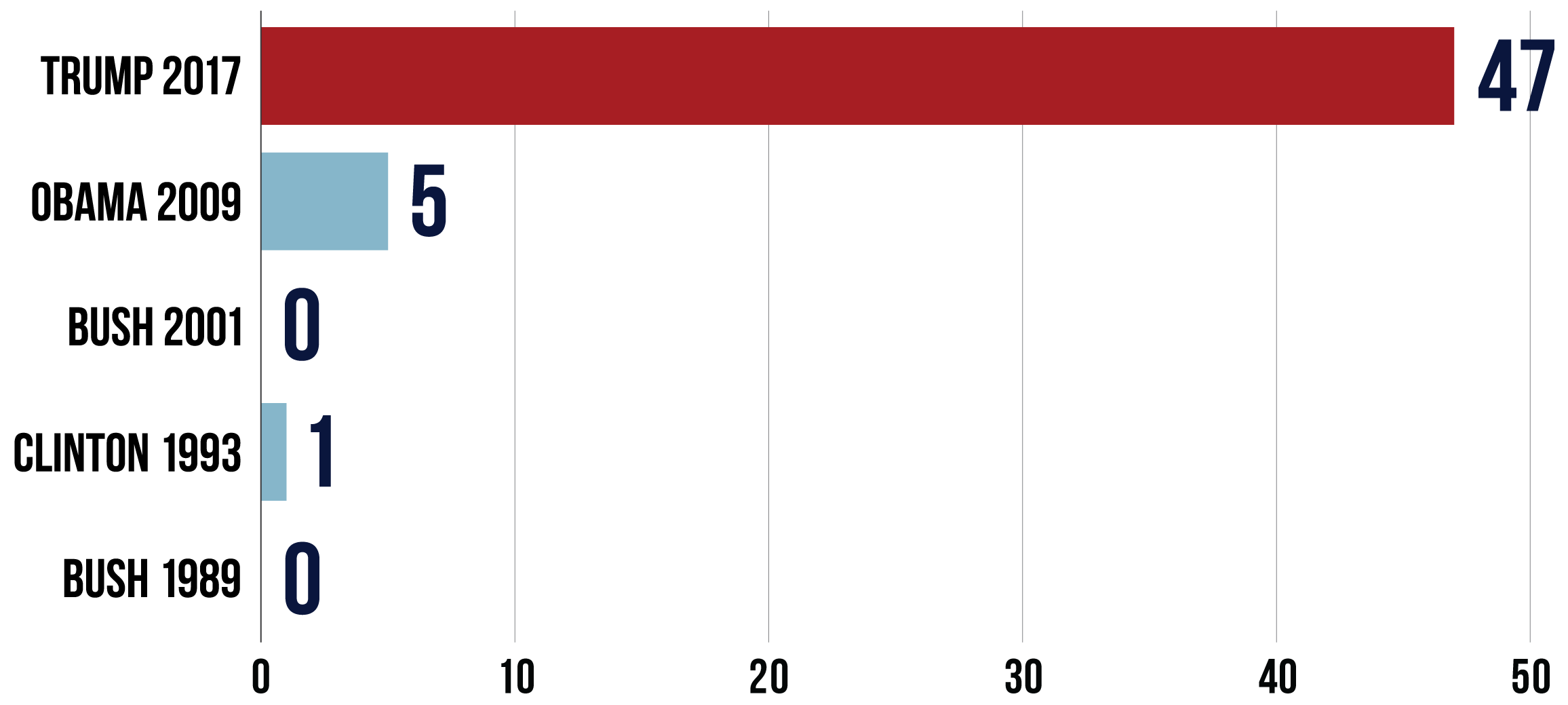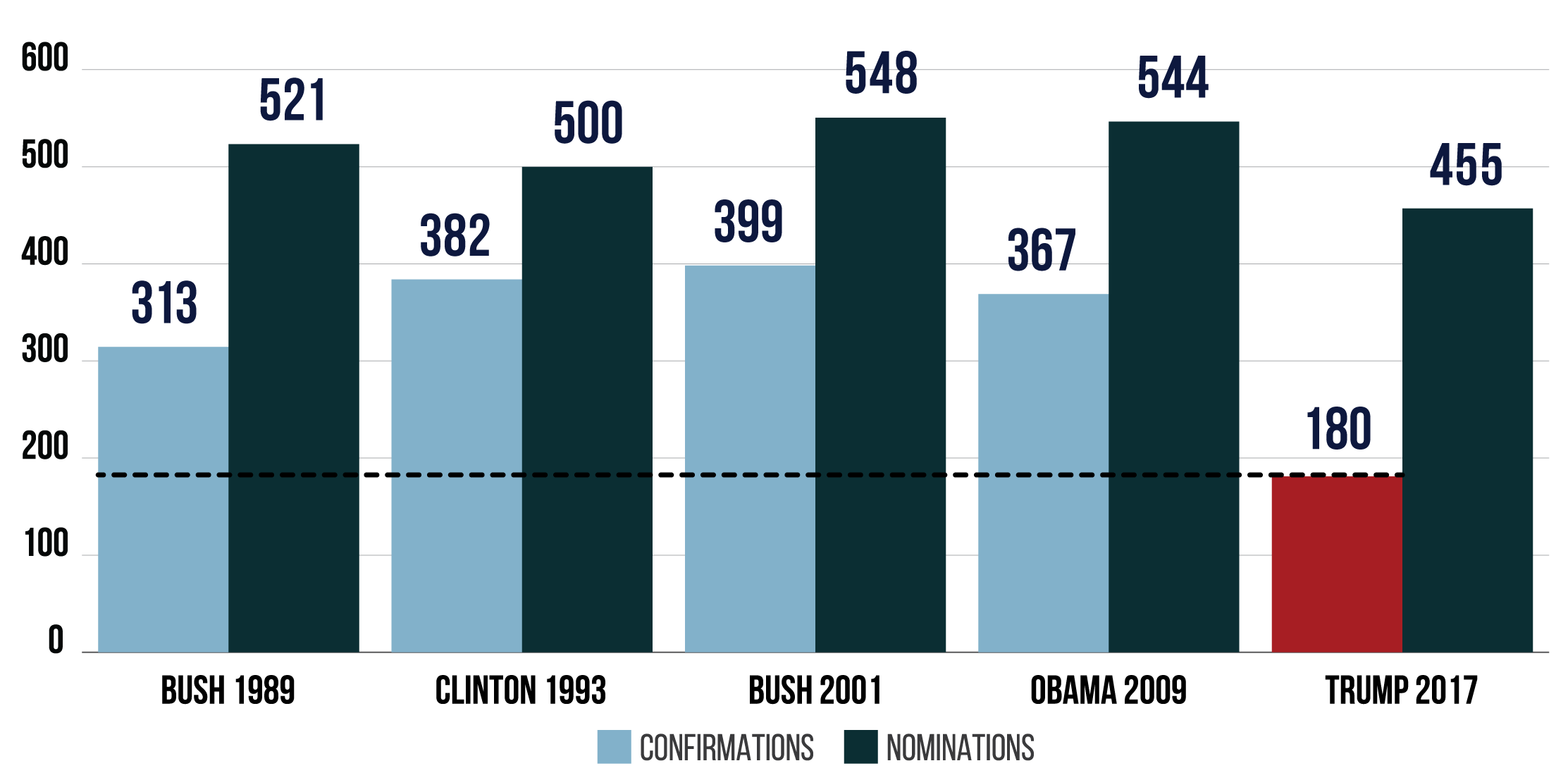Democrats’ Nomination Blockade Continues
- Democrats have forced the Senate to take 47 cloture votes on nominees in 2017, compared to a total of six votes at this point in the previous four administrations combined.
- It is taking an average of 63 days to confirm each of this administration’s key executive branch nominees, versus 47 days for President Obama’s nominees.
- Due to the Democrats’ obstruction, this administration has had the lowest percentage of nominees confirmed of any administration in the past 30 years.
Senate Democrats continue to impede the Republican majority from staffing the administration with qualified public servants and confirming key judges. Their strategy has involved putting up procedural roadblocks, like needless cloture votes on nominees who have strong or even unanimous bipartisan support. This obstruction has wasted the Senate’s time and distracted from legislative business. It is also a disservice to the American public, which suffers without qualified appointees working in important government roles.
Cloture Votes by October 27

Democrats have forced needless cloture votes on non-controversial nominees simply to delay confirmation and signal their “resistance” to President Trump. With more than 1,000 executive branch slots and 100 judicial vacancies to fill, Democrats have many opportunities to threaten filibusters to delay action in the Senate. These tactics are purely dilatory. Almost none of the post-cloture time has been used to debate non-controversial nominees, the Senate is simply forced to run out the clock. Through October 27, Trump nominees required 47 cloture votes, compared to only five Obama nominees who required cloture during the same time period.
using senate procedure as a weapon of delay
The cloture process takes a lot of time. Not only does the process of invoking cloture lead to additional procedural votes, but Senate Rule 22 provides for up to “thirty hours of consideration of the measure, motion, or other matter on which cloture has been invoked.”
Looking back, the Democrats have had a clear strategy from the day President Trump won the election. Even before he was inaugurated, liberal groups demanded obstruction from Senate Democrats. In response, Senator Chris Murphy vowed to “smash precedent” to stymie the administration. Senator Jeff Merkley – one of six senators in what Politico has called the “Hell No Caucus” – vowed in May to obstruct nominees purely as a “bit of a protest” against Republicans.
Just last week, Democrats forced cloture votes on two district court nominees who had broad bipartisan support – and then voted overwhelmingly for confirmation. One of these judges, Scott Palk, had been previously nominated by President Obama, and in 2016 his nomination was favorably reported out of the Judiciary Committee by voice vote. This year, three Democrats on the committee changed their minds and voted against Judge Palk after he was nominated by a Republican president, but his nomination still passed out of the committee by a wide margin. Despite having solid bipartisan support, Democrats still forced Republicans to file and invoke cloture on the nomination. The cloture motion on Judge Palk’s nomination was invoked by a landslide vote of 79–18. After forcing the Republicans to waste almost an entire week of floor time waiting for cloture to ripen, Judge Palk was confirmed by a bipartisan vote of 79–16.
The same pattern held for another nominee, Trevor McFadden, whose nomination was reported out of the Judiciary Committee by voice vote. When the nomination reached the floor, Democrats still forced a cloture vote. Cloture was invoked on his nomination by a vote of 85-12, and he was confirmed 84-10. Although both of these mainstream, capable judges were ultimately confirmed, the Democrats still forced Republicans to use a significant amount of floor time that could have been used for more productive business.
Democrats Are dragging their feet
Unfortunately, the Democrats’ delay tactics are having a serious effect on the ability of the administration to staff the government. In President Trump’s first nine months in office, he nominated 455 people for executive branch positions, which is consistent with other recent presidents. At a similar point in President Obama’s first term, he had made 544 executive branch nominations. President George W. Bush made 548 nominations in his first nine months, President George H.W. Bush nominated 521 people, and President Clinton nominated 500. Unlike past administrations, the Senate has confirmed only 180 Trump nominees through October 27, which is 219 fewer than President George W. Bush and 187 fewer than President Obama.
Executive Branch Nominations and Confirmations through October 27

At this point in the term of President George H.W. Bush, he had 60 percent of his nominees confirmed. The Senate had confirmed 76 percent of President Clinton’s nominees, 73 percent of President George W. Bush’s, and 67 percent of President Obama’s nominees at the same point in their first terms. President Trump, by contrast, has had fewer than 40 percent of his nominees confirmed.
According to the nonpartisan Partnership for Public Service, it is taking the Senate an average of 63 days to confirm President Trump’s executive branch nominees. At this point in President Obama’s term, his nominees were waiting 47 days for confirmation, compared with 33 days for President George W. Bush’s nominees, 36 days for President Clinton’s nominees, and 45 days for President George H.W. Bush’s nominees.
Next Article Previous Article
